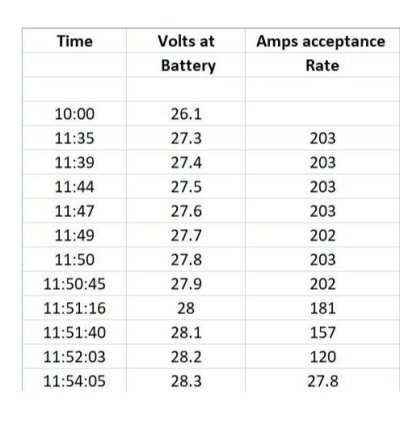Interesting thread as I have been evaluating a LiFePO4 bank for several weeks.
The boat has an (overly)complex, but flexible, DC system. In fact I just wrote, and then deleted, a lengthy description - too much detail for casual reading. Cutting to the bottom line:
We need new house batteries. During our last cruise (5 months, Bahamas, mostly at anchor) the batteries became increasingly resistant to charge rates and quickly discharged to lower voltages.
I would replace the house batteries (5 x 250 AH AGM's) with 3 x Victron 200 AH LiFePO4's. These are the easiest fit from size/weight/capacity viewpoints.
What I'm struggling with is the need for new charging and control equipment. Vendors, of course, recommend an entirely new system. I would like to use what I have, otherwise it becomes significantly more expensive.
> MS2812 Magnum Charger/Inverter with battery monitor kit and ME-RC remote controller. Charges at maximum 125 amps.
> A 160 amp Leece-Neville alternator with 3-stage Heart regulator.
I am considering:
> An external battery management system (probably Victron BMS 12/200) as the Victron batteries do not have an internal BMS.
> Upgrade the Magnum ME-RC controller to the ME-ARC controller as it has significantly more options to control the charger.
> A new alternator regulator which could fit the LiFePO4 charge profile and unload the alternator if it overheated.
Even these upgrades will probably cost ~$1K but would save the cost of a new inverter/charger, controller and shunt.
We will also evaluate PV panels after the battery system is implemented.
Any experience or thoughts are appreciated.
Your use case sounds pretty much identical to mine. Three years ago I swapped 1280 Ah of AGM NorthStar for 600 Ah of LiFePO4 from Lithionics with their external BMS, all 24 v. I had a Trace 4000 with 130 amp charger, an Ample Power 160 amp alternator, Balmar MC 624 voltage regulator and the genset. In addition, I had a 200 amp LA starter bank and two rotary on/off switches for the LFP house bank and starter bank. I changed nothing in the charging equipment, because there was no need, although I did add three 30 Amp Sterling chargers to allow me to recharge from the genset/inverter charger/Sterlings at 200 amps, or 300 amps if I run both engine and genset.
Concerns about safety of LFP vs. LA are, IMO, basically horse pucky due to confusing LiFePO4 with other chemistries, and the anguish over charging equipment perplexes me as I find it easier to maintain the LFP bank than the one it replaced. If I use 300 amps and recharge at 200, in 90 minutes the batteries are full. Use, re-charge, rinse and repeat. Simple.
Managing the bank boils down to three scenarios:
1. At anchor for days: BMS on, starter bank switched off. Consume 450 Ah or so, then fire up the genset to recharge at 200 amps. Make water, do laundry, etc. to keep my oversized genset loaded up a bit.
2. At the dock, connected to shore power: BMS off, starter bank on. Float charge current directed to the LA starter bank, with the LFP bank stored off line at around 50% SoC.
3. Underway, LFP bank at less than full charge: BMS on, Starter bank switched off. Re-charge with alternator, and when acceptance rate of the LFP bank drops to <3% or so, switch starter bank on, Starter bank on, BMS off.
The MC624 is set for a conservative charge profile for LFP, which works just fine for the LA starter bank. The Sterlings and the Trace charger are set for 29.2 volts bulk with absorption time however long it takes for the charge acceptance rate to drop to <3%, which happens about 3 minutes after the CAR stops to drop. I can predict within 5 minutes of that drop starting to happen since the acceptance rate of LFP is basically flat until full, at least with the Lithionics batteries. I monitor that acceptance rate with a Link 20 monitor that displays amps in and out. I've posted the image below before, but it shows how flat the charge curve is, and how quickly it drops.
I chose Lithionics because all they do is Lithium batteries, buy in bulk, then match the impedance of cells before assembling them into packs, and their BMS is reputably the best there is. Mine are 2 x 300 amps @ 24 vdc each.
Hope that helps.


